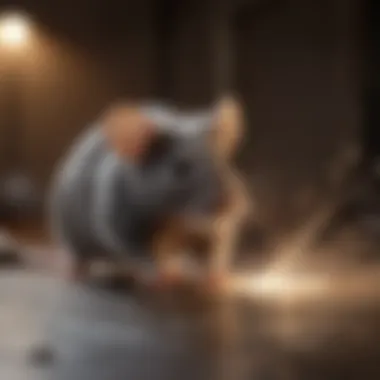Naturally Banish Mice: Eco-Friendly Home Remedies Revealed


Animal Species Profile
When it comes to mice infestations, understanding the animal species is crucial. Mice are nocturnal rodents known for their keen sense of hearing and smell, which they use to navigate their environment and find food. These small mammals typically have a sleek body, rounded ears, and a long hairless tail. They are incredibly agile and can squeeze through tiny openings, making them challenging pests to eliminate. Mice are omnivores, feeding on a variety of foods from grains to meats, and have a rapid reproductive rate, leading to quick population growth within homes.
Natural Habitat and Distribution
Mice are adaptable creatures that can thrive in various environments, including fields, forests, and human dwellings. They are commonly found across the globe, with species like the house mouse being particularly widespread due to their close association with human habitats. In homes, mice tend to nest in secluded areas near a food source, such as behind walls, in attics, or under cabinets. Understanding their preferred habitats is essential for effective pest control measures.
Behavior and Social Interactions
Mice exhibit complex social behaviors within their colonies, forming hierarchies and sharing resources to ensure group survival. They are known for their excellent communication skills using a combination of vocalizations, body language, and scent markings. Mice are also highly adaptable and can quickly adjust their behaviors to new environments or threats, making them resilient pests in urban settings. By delving into their behavior patterns, homeowners can develop targeted strategies to deter and remove mice effectively."
Understanding the Mouse Problem
In this segment, we delve into the critical aspect of understanding the mouse infestation. By unraveling the signs of a mice invasion, homeowners can promptly address the issue before it escalates. Recognizing these signs early on is key to effective pest management. Understanding the nuances of mouse behavior and habitude is essential for implementing targeted eradication techniques. Without a thorough grasp of the problem at hand, attempts to eliminate mice can be futile and frustrating. Therefore, the comprehensive examination of the mouse problem equips readers with the knowledge needed to tackle infestations efficiently.
Identifying Signs of Mice Infestation
Droppings
Droppings play a crucial role in signaling a mice infestation within a household. These minute fecal pellets are clear indicators of rodent activity and are often found in secluded corners or along baseboards. Their cylindrical shape and dark coloring distinguish them from other droppings, aiding in prompt identification. Despite their undesirable presence, droppings serve as valuable clues for locating mouse pathways and nesting sites. Understanding the significance of droppings facilitates the implementation of targeted pest control measures, ensuring a proactive response to infestations.
Gnawed Items
The presence of gnawed items signifies the destructive impact of mice within a living environment. From gnawed wires to damaged furniture, these telltale signs highlight the voracious feeding habits of rodents. Commonly targeted items include cardboard boxes, electrical insulation, and stored food products. By recognizing these distinctive markings on household items, residents can detect the extent of infestation and employ appropriate counteractive measures. Understanding the implications of gnawed items guides homeowners in safeguarding their property against further damage, emphasizing the importance of swift intervention.
Nesting Materials
Nesting materials present an additional indicator of a mice infestation, offering insights into rodent nesting behaviors. These materials, such as shredded paper, fabric scraps, and dried plants, are meticulously arranged in sheltered areas for breeding purposes. The presence of nesting materials in attics, basements, or wall cavities underscores the persistence of mice within the vicinity. By identifying and removing these nesting sites, individuals can disrupt the rodents' reproductive cycle and impede population growth. Understanding the significance of nesting materials aids in dismantling rodent shelters, mitigating the risk of recurrent infestations and property damage.


Health Risks Associated with Mice
Coming Soon
Natural Deterrents for Mice
In this article, the focus shifts towards utilizing natural deterrents for mice, a topic of significant importance in the realm of pest control. Natural deterrents offer a safe and eco-friendly alternative to harsh chemicals, resonating with those inclined towards humane solutions. By incorporating natural elements into pest management strategies, individuals not only combat mouse infestations effectively but also contribute to a healthier environment. The discussion on natural deterrents emphasizes the balance between efficacy and sustainability, highlighting the essence of embracing natural remedies in the fight against mice.
Peppermint Oil
Application Methods
Peppermint oil, renowned for its potent scent, serves as a key player in deterring mice infestations. The practicality of application methods involving peppermint oil lies in its simplicity and accessibility. Mixing a few drops of peppermint oil with water and spraying it around potential entry points creates a hostile environment for mice, compelling them to seek refuge elsewhere. The distinct fragrance of peppermint oil not only masks attractants for mice but also disrupts their sensory cues, hindering their navigation within living spaces. While the application methods of peppermint oil showcase ease of use and non-toxicity, it is essential to reapply the solution periodically for sustained effectiveness.
Effectiveness
The effectiveness of peppermint oil as a natural deterrent against mice stems from its ability to alter their behavior without causing harm. Mice, known for their keen sense of smell, find the strong aroma of peppermint oil unbearable, prompting them to steer clear of treated areas. Unlike chemical repellents that pose risks to household members and pets, peppermint oil offers a gentle yet robust solution to mouse infestations. Additionally, the versatility of peppermint oil extends beyond deterring mice, as it also serves aromatherapeutic purposes for humans. While its effectiveness in repelling mice is notable, considering individual sensitivity to scents is crucial to ensure optimal results.
Cloves and Clove Oil
Usage Instructions
Cloves and clove oil emerge as potent allies in the battle against mice, courtesy of their unique properties and ease of utilization. Utilizing cloves or clove oil involves strategically placing these items near entry points or areas frequented by mice. The aromatic intensity of cloves acts as a natural barrier, deterring mice from venturing further into living spaces. Moreover, incorporating clove oil into cleaning solutions amplifies its repellent effects, safeguarding homes from potential infestations. The user-friendly nature of cloves and clove oil instructions makes them an appealing choice for individuals seeking practical and natural solutions to mice intrusion.
Impact on Mice Behavior
The impact of cloves and clove oil on mice behavior underscores their disruptive influence on traditional nesting and foraging patterns. Mice, sensitive to changes in their environment, display aversion towards the sharp scent emitted by cloves or clove oil. This aversion translates into altered behavior, prompting mice to reconsider their presence within treated areas. Furthermore, the sustained impact on mice behavior due to cloves or clove oil contributes to long-term deterrence, reducing the likelihood of recurring infestations. While the efficacy of cloves and clove oil in repelling mice is remarkable, understanding the optimal placement and concentration of these repellents is essential for maximizing their effectiveness.
Ammonia Soak
Preparation


Crafting an ammonia soak as a mouse deterrent involves diluting ammonia with water in a well-ventilated area to ensure safety during preparation. The distinctive odor of ammonia permeates the air upon mixing, creating an inhospitable environment for mice. Proper preparation of the solution entails wearing protective gear, handling ammonia with care, and adhering to recommended dilution ratios to prevent accidental exposure. The accessibility of ammonia as a household item contributes to its popularity as a DIY mouse repellent, offering a cost-effective and efficient solution for addressing infestations.
Application
Applying the prepared ammonia soak along entry points or areas susceptible to mice infestations aids in creating a deterrent barrier that dissuades rodent activity. The liquid consistency of the solution allows for easy dispersion, reaching crevices and corners that are potential hideouts for mice. The application of ammonia soak not only repels existing mice but also serves as a preventative measure against future intrusions. Despite its effectiveness, caution must be exercised while handling and applying ammonia soak, ensuring minimal exposure to humans and pets. Regular application of the solution reinforces its efficacy, maintaining a mouse-free environment over time.
DIY Traps and Repellents
In the realm of home remedies for mice infestation, DIY traps and repellents play a pivotal role. These methods offer a practical and efficient approach to addressing the issue without resorting to harsh chemicals or professional help. DIY traps and repellents provide a cost-effective and environmentally friendly solution for those dealing with a mouse problem in their homes. By taking a hands-on approach and implementing homemade solutions, individuals can effectively manage and deter mice infestations, ensuring a safe and healthy living environment.
Bucket Trap
Construction Steps
The construction of a bucket trap involves a few straightforward steps, making it a convenient option for individuals looking to catch mice effectively. One of the key characteristics of the bucket trap's construction is its simplicity. By using common household items and basic tools, individuals can assemble a functional trap in no time. The unique feature of the construction steps lies in its adaptability. Homeowners can customize the trap size and bait placement based on their specific needs and the layout of their space. While the construction steps offer ease and efficiency, a potential disadvantage could be the initial time investment required to set up the trap properly.
Baiting Techniques
When it comes to baiting techniques for the bucket trap, the choice of bait plays a crucial role in its effectiveness. Utilizing appealing baits such as peanut butter or cheese can attract mice to the trap, increasing the likelihood of catching them. The key characteristic of baiting techniques is their ability to lure mice into the trap by appealing to their sense of smell. This method is popular among DIY enthusiasts due to its simplicity and cost-effectiveness. One unique feature of baiting techniques is the opportunity to experiment with different types of bait to maximize capture rates. While baiting techniques offer a practical and humane approach to mouse control, a potential disadvantage could be the need for regular monitoring and bait replacement to ensure continuous efficacy.
Ultrasonic Repellers
Mechanism
Ultrasonic repellers operate by emitting high-frequency sound waves that are inaudible to humans but disturb and deter mice. The key characteristic of the ultrasonic repeller's mechanism is its non-toxic nature, making it a safe alternative to chemical repellents. This technology is a popular choice for individuals seeking a hands-off approach to mouse deterrence. One unique feature of ultrasonic repellers is their ability to cover large areas, making them ideal for use in spacious rooms or multiple rooms simultaneously. While the mechanism of ultrasonic repellers provides a convenient and eco-friendly solution, a potential disadvantage could be interference from obstacles that may disrupt the sound waves' transmission.
Efficacy
When evaluating the efficacy of ultrasonic repellers, it is essential to consider factors such as room size and layout, as well as the presence of furniture or other objects that could impede the repellent's reach. The key characteristic of the repeller's efficacy is its non-invasive nature, allowing individuals to deter mice without causing harm to the pests or using harmful chemicals. This method is a beneficial choice for those looking to maintain a peaceful living environment free from unwanted guests. One unique feature of the efficacy of ultrasonic repellers is the continuous operation without the need for frequent maintenance or replacements. While ultrasonic repellers offer a convenient and advanced solution for mouse deterrence, a potential disadvantage could be the time it takes for the repellent to show noticeable effects.
Homemade Spray Repellent


Ingredients
The homemade spray repellent requires simple ingredients such as vinegar, peppermint oil, and water, making it a safe and natural option for individuals concerned about chemical exposure. The key characteristic of the ingredients used in the spray repellent is their olfactory properties that mice find repulsive. This homemade solution is a popular choice among environmentally conscious homeowners seeking a non-toxic approach to pest control. One unique feature of the ingredients is their versatility, allowing individuals to customize the repellent based on personal preferences and ingredient availability. While the ingredients in the homemade spray repellent offer a natural and effective solution for mouse deterrence, a potential disadvantage could be the need for regular reapplication to maintain its potency.
Application Tips
When applying the homemade spray repellent, it is essential to focus on potential entry points for mice, such as cracks, crevices, or areas near food sources. The key characteristic of the application tips is their targeted approach, ensuring maximum coverage in areas prone to mouse activity. This method is a beneficial choice for individuals looking to proactively prevent infestations and protect their homes. One unique feature of the application tips is their adaptability to different surfaces and environments, allowing for versatile use indoors and outdoors. While the application tips offer a practical and eco-friendly solution for mouse deterrence, a potential disadvantage could be the need for repeated applications, especially in high-traffic areas.
Maintaining a Mouse-Free Environment
Maintaining a mouse-free environment is paramount in addressing and preventing rodent infestations. By implementing effective strategies to keep mice away, homeowners can safeguard their health and protect their property from damage. Proper maintenance of living spaces is crucial not only for aesthetic purposes but also for ensuring a hygienic environment free from potential health hazards. In this section, we will delve into key practices that promote a mouse-free environment, emphasizing the significance of proactive measures in creating a harmonious and safe living space.
Proper Food Storage
Proper food storage plays a pivotal role in deterring mice from invading homes. Containers are essential components of maintaining food hygiene and preventing rodents from accessing food sources. These airtight receptacles are designed to safeguard perishable items and dry goods from contamination and infestation. The quality of containers significantly impacts the freshness and longevity of food supplies, making them a preferred choice for storage solutions. The durability and seal-tight capabilities of containers ensure that stored food remains protected against pests, including mice. While containers offer optimal protection, they also contribute to organized storage spaces, facilitating easy access and inventory management.
Sealing techniques complement proper food storage by fortifying entry points that mice could exploit to gain access to food sources. Effective sealing methods involve identifying and closing off potential entry points such as gaps in walls, windows, and doors. By utilizing appropriate sealants, homeowners can prevent rodent intrusion and reinforce the structural integrity of their living spaces. The meticulous application of sealants enhances the overall security of the premises, making it challenging for pests like mice to infiltrate. While sealing techniques contribute to a secure environment, they also aid in conserving energy by minimizing heat loss and maintaining indoor temperatures.
Sealing Entry Points
Securing common entryways is a fundamental aspect of preventing mice from entering homes and establishing nests. Common entryways include gaps around plumbing installations, vents, and utility lines that serve as potential access points for rodents. By addressing these openings with suitable barriers or blockers, individuals can effectively restrict rodent movement and nesting activities. Common entryways are often overlooked but play a vital role in safeguarding homes against pest infestations. Their strategic reinforcement through reliable sealants enhances the structural integrity of buildings and promotes overall hygiene and sanitation.
Recommended sealants are essential for providing a durable and long-lasting barrier against rodent intrusion. These specialized products offer superior adhesion and flexibility, ensuring a tight seal on various surfaces and materials. Recommended sealants exhibit resistance to environmental factors such as moisture and temperature fluctuations, guaranteeing optimal performance in diverse conditions. By choosing high-quality sealants recommended for pest control purposes, homeowners can fortify their premises against unwanted intruders and maintain a secure living environment that prioritizes safety and comfort.
Seeking Professional Assistance
Seeking professional assistance in dealing with mouse infestations is a crucial step in effectively addressing the issue. Pest control experts bring a wealth of knowledge and experience to tackle persistent infestations with precision and efficiency. Their expertise in identifying entry points, behaviors, and appropriate treatment measures can significantly aid in eradicating mice from your home environment. By consulting professionals, you can ensure a comprehensive and long-lasting solution to your mouse problem.
When to Consult Pest Control
Persistent Infestations
Persistent infestations present a significant challenge for homeowners, indicating a severe underlying issue. These infestations are characterized by the continuous presence of mice despite DIY efforts or temporary remedies. Consulting pest control for persistent infestations is essential to address the root cause and implement targeted extermination methods. Pest experts can conduct thorough inspections, devise tailored treatment plans, and provide ongoing monitoring to prevent future infestations. While the cost may be higher for professional services, the effectiveness and lasting results outweigh the initial investment.
Health Concerns
Health concerns associated with mouse infestations pose serious risks to both humans and pets within the household. Mice can carry diseases, contaminate food sources, and trigger allergic reactions in sensitive individuals. Addressing health concerns promptly by consulting pest control is paramount to safeguarding the well-being of your family. Pest professionals implement safe and environmentally friendly practices to eliminate mice while minimizing health hazards. Additionally, they can offer recommendations for sanitation practices and preventive measures to uphold a healthy living environment for all occupants.







